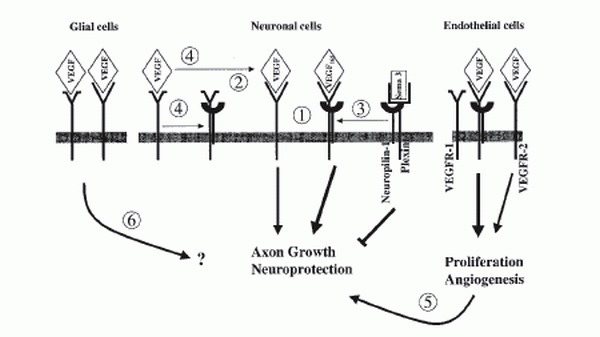From: Vascular Endothelial Growth Factor

NCBI Bookshelf. A service of the National Library of Medicine, National Institutes of Health.

Hypothetical model of VEGF-mediated neuroprotection. Various VEGF receptors are expressed on glial, neuronal and endothelial cells. 1) VEGF signals through binding to VEGFR-2 on neurons. Additional complex formation with neuropilin-1 enhances this signal. 2) Neuropilin-1 binds the sink receptor VEGFR-1 thereby releasing VEGF, which then can bind to and signal through VEGFR-2. 3) Complex formation between VEGF and neuropilin-1 inhibits formation of the semaphorin-plexin-neuropilin complex, thereby counteracting the repellent and apoptotic function of semaphorin 3A. This in turn leads to axonal outgrowth and neuroprotection. 4) Regulation of VEGFR-1 expression which is able to bind both VEGF and neuropilin-1, in turn determines the amount of available VEGF for binding to VEGFR-2 as well as of neuropilin-1 for the formation of the semaphorin-plexin-neuropilin complex. 5) VEGF-mediated endothelial cell proliferation leads to new vessel growth, thereby allowing enhanced oxygen and nutrient delivery to neuronal cells which in turn increases cell survival. 6) VEGF-mediated proliferation of astrocytes might help to stabilize neuronal function.
From: Vascular Endothelial Growth Factor

NCBI Bookshelf. A service of the National Library of Medicine, National Institutes of Health.